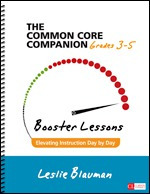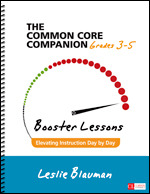The Common Core Companion: Booster Lessons, Grades 3-5
Elevating Instruction Day by Day
- Leslie Blauman - National and International Literacy Consultant
Corwin Literacy
English/Language Arts Common Core | Reading (Primary/Elementary) | Writing (Primary/Elementary)
You can find hundreds of literacy lessons in hundreds of places—but none of them will do for students what the ones in this book do. What’s the magic bullet? Potent integration.
In this follow-up to her Common Core Companion, Grades 3-5, Leslie Blauman provides an ample supply of connected lessons you can use as booster shots when your students need a good dose of integrated reading and writing instruction. The 50+ lessons are divided into five learning sequences that span the ELA standards, bringing a Monday-through-Friday clarity to a process that often overwhelms teachers and coaches alike.
Follow each sequence and week by week, you’ll build the instructional potency to help students achieve a year’s worth of growth as you integrate:
1. Reading Craft and Structure with Opinion Writing
2. Opinion Writing with Evaluating Argument in Informational Text
3. Narrative Writing with Craft and Structure (words, phrases, key ideas, setting, character, and events)
4. Informative/Explanatory Text Writing with Reading for Key Ideas
5. Research to Build and Present Knowledge with Integration of Knowledge and Ideas in Reading
Need a great kickoff to a unit of study or review/intervention lessons toward the end of a unit? Leslie’s booster lessons are eminently “dippable.” Or use her book and its companion website as a planner for deeper, longer-term instructional design. The Common Core Companion Booster Lessons, Grades 3-5, is the resource you’ll turn to again and again for various purposes throughout the year.
Free resources

Booster Reading Lesson Informational Text
Use this lesson from The Common Core Companion Booster Lessons, Grades 3-5, to explain to students how an author uses reasons and evidence in informational text.

